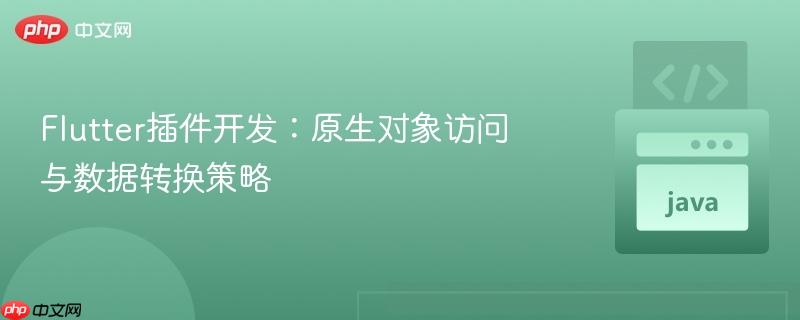
本文探讨了在Flutter插件中访问原生平台(Android/iOS)复杂对象的方法。重点介绍了通过MethodChannel进行数据交互时,如何有效地处理原生对象。文章对比了直接传递对象引用和使用数据映射(Map)进行数据转换两种方案,并提供了相应的代码示例,帮助开发者选择最适合自身需求的方案,实现Flutter与原生平台之间的高效通信。
在开发Flutter插件时,经常需要访问原生平台(Android/iOS)的特定对象,尤其是那些复杂的、继承自多个类的对象。直接在Dart端重新实现这些原生对象通常是不现实的,因此需要在Flutter和原生平台之间找到一种有效的数据交互方式。本文将探讨两种主要的方案:直接传递对象引用和使用数据映射(Map)进行数据转换,并分析它们的优缺点。
这种方案的核心思想是在原生平台创建对象实例后,将该实例的引用(例如,内存地址)传递给Dart端。Dart端保存这个引用,并在后续调用原生方法时,将该引用传递回去,原生平台根据引用找到对应的对象实例,执行相应操作。
示例代码(基于问题中的代码):
Dart端:
class Peripheral {
late String _objectReference;
late String _localName, _uuid;
Peripheral({required String localName, required String uuid}) {
_uuid = uuid;
_localName = localName;
_newPeripheralInstance(localName, uuid);
}
Future<void> _newPeripheralInstance(String localName, String uuid) async {
_objectReference = (await PeripheralPlatform.instance.newPeripheralInstance(localName, uuid))!;
return;
}
String get objectReference => _objectReference;
Future<String?> getModelName() async {
return PeripheralPlatform.instance.getModelName(_objectReference);
}
Future<String?> getUuid() async {
return PeripheralPlatform.instance.getUuid(_objectReference);
}
}
abstract class PeripheralPlatform {
static PeripheralPlatform get instance => _instance;
static late PeripheralPlatform _instance;
static set instance(PeripheralPlatform instance) {
_instance = instance;
}
Future<String?> newPeripheralInstance(String localName, String uuid) {
throw UnimplementedError('newPeripheralInstance() has not been implemented.');
}
Future<String?> getModelName(String peripheralReference) {
throw UnimplementedError('getModelName() has not been implemented.');
}
Future<String?> getUuid(String peripheralReference) {
throw UnimplementedError('getUuid() has not been implemented.');
}
}
class MethodChannelPeripheral extends PeripheralPlatform {
/// The method channel used to interact with the native platform.
static const MethodChannel methodChannel = MethodChannel('channel');
@override
Future<String?> newPeripheralInstance(String localName, String uuid) async {
String? instance = await methodChannel.invokeMethod<String>('Peripheral-newPeripheralInstance', <String, String>{
'localName': localName,
'uuid': uuid
});
return instance;
}
@override
Future<String?> getModelName(String peripheralReference) async {
return await methodChannel.invokeMethod<String>('Peripheral-getModelName', <String, String>{
'peripheralReference': peripheralReference
});
}
@override
Future<String?> getUuid(String peripheralReference) async {
return await methodChannel.invokeMethod<String>('Peripheral-getUuid', <String, String>{
'peripheralReference': peripheralReference
});
}
}Android端(Java):
import io.flutter.plugin.common.MethodCall;
import io.flutter.plugin.common.MethodChannel;
import java.util.HashMap;
import java.util.Map;
public class PluginPeripheral {
private static Map<String, Peripheral> peripheralMap = new HashMap<>();
public static void handleMethodCall(String method, MethodCall call, MethodChannel.Result result) {
method = method.replace("Peripheral-", "");
switch (method) {
case "newPeripheralInstance":
newPeripheralInstance(call, result);
break;
case "getModelName":
getModelName(call, result);
break;
case "getUuid":
getUuid(call, result);
break;
default:
result.notImplemented();
break;
}
}
private static void newPeripheralInstance(MethodCall call, MethodChannel.Result result) {
if (call.hasArgument("uuid") && call.hasArgument("localName")) {
String uuid = call.argument("uuid");
String localName = call.argument("localName");
if (localName == null || uuid == null) {
result.error("Missing argument", "Missing argument 'uuid' or 'localName'", null);
return;
}
Peripheral peripheral = new Peripheral(localName, uuid);
peripheralMap.put(peripheral.toString(), peripheral);
result.success(peripheral.toString());
}
}
private static void getModelName(MethodCall call, MethodChannel.Result result) {
if (call.hasArgument("peripheralReference")) {
String peripheralString = call.argument("peripheralReference");
if (peripheralString == null) {
result.error("Missing argument", "Missing argument 'peripheral'", null);
return;
}
Peripheral peripheral = peripheralMap.get(peripheralString);
if (peripheral == null) {
result.error("Invalid peripheral", "Invalid peripheral", null);
return;
}
result.success(peripheral.getModelName());
} else {
result.error("Missing argument", "Missing argument 'peripheralReference'", null);
}
}
private static void getUuid(MethodCall call, MethodChannel.Result result) {
if (call.hasArgument("peripheralReference")) {
String peripheralString = call.argument("peripheralReference");
if (peripheralString == null) {
result.error("Missing argument", "Missing argument 'peripheral'", null);
return;
}
Peripheral peripheral = peripheralMap.get(peripheralString);
if (peripheral == null) {
result.error("Invalid peripheral", "Invalid peripheral", null);
return;
}
result.success(peripheral.getUuid());
} else {
result.error("Missing argument", "Missing argument 'peripheralReference'", null);
}
}
}优点:
缺点:
这种方案将原生对象转换为Map数据结构,通过MethodChannel传递Map数据,Dart端接收到Map数据后,再将其转换为Dart对象。
示例代码:
Dart端:
class Device {
String? id;
String? name;
Device({this.id, this.name});
Device.fromMap(Map<String, dynamic> map) {
id = map['id'];
name = map['name'];
}
}
// 调用原生方法,并进行数据转换
Future<Device> requestDevice() async {
final map = await MethodChannelPeripheral.methodChannel.invokeMethod('requestDevice');
return Device.fromMap(map.cast<String, dynamic>());
}Android端(Kotlin):
data class Device(
val id: String,
val name: String?
) {
fun toMap(): Map<String, Any?> {
return mapOf(
"id" to id,
"name" to name
)
}
}
override fun onMethodCall(@NonNull call: MethodCall, @NonNull result: Result) {
when (call.method) {
"requestDevice" -> {
// 获取Device对象
val device = Device("123", "My Device")
// 将Device对象转换为Map
result.success(device.toMap())
}
else -> {
result.notImplemented()
}
}
}优点:
缺点:
两种方案各有优缺点,选择哪种方案取决于具体的应用场景和需求。
在实际开发中,可以结合两种方案的优点,例如,对于一些关键属性,可以使用数据映射进行传递,对于一些复杂操作,可以使用对象引用进行调用。此外,还可以考虑使用序列化/反序列化技术,将原生对象转换为JSON或其他格式的数据,以便在Flutter和原生平台之间进行传递。
无论选择哪种方案,都需要仔细评估其性能影响,并进行充分的测试,以确保Flutter插件的稳定性和可靠性。
以上就是Flutter插件开发:原生对象访问与数据转换策略的详细内容,更多请关注php中文网其它相关文章!

每个人都需要一台速度更快、更稳定的 PC。随着时间的推移,垃圾文件、旧注册表数据和不必要的后台进程会占用资源并降低性能。幸运的是,许多工具可以让 Windows 保持平稳运行。

Copyright 2014-2025 https://www.php.cn/ All Rights Reserved | php.cn | 湘ICP备2023035733号